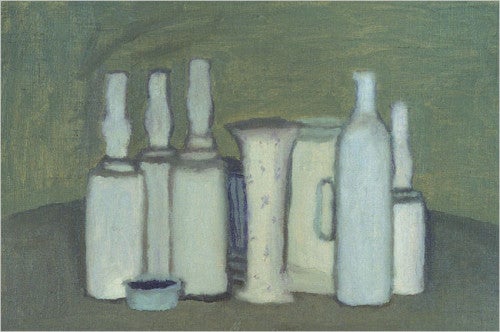
I am not comfortable with only what I know; it is what I don’t know that I am always seeking. That is why I pay attention when confronting an artist’s work that, at first, I don’t respond to. As an artist, what I find most useful is to have my eyes opened by someone else’s work that is very unlike mine.
I remember the first time I encountered Giorgio Morandi’s work—I hated it. The subject was a repetitive parade of badly drawn dusty bottles and boxes typically in the center of the composition. “Not much color sense,” I thought, “can’t he find a bright red in his palette? How can someone spend a lifetime painting the same objects over and over again?”

oil on canvas, 77 by 62 inches. Exhibited in the 2000 Whitney Biennial.
Many years later, I stood in front of three Morandis and I was dumbstruck. Upon looking, I found nuances in that work that I had never seen before—a color sense that was very reserved yet seemed expansive in that very contained world that he was depicting. An array of grays went from cool to warm as slowly as honey drips from a spoon. I was mesmerized by the paintings’ awkwardness and yet elegant simplicity. What once looked like bad drawing now seemed personal, autobiographical. The tentativeness of the brushstrokes—this wasn’t about flinging paint around and making noise, this was about being quiet. It is almost as if these paintings contained a question and answer and at the same time also expressed a lot of doubt. Not all of Morandi’s work feels this way to me. Some of his paintings are clumsy. But, I do appreciate an artist that makes great work and also stumbles.
I first saw Lisa Yuskavage’s paintings a few years ago. What a turn-off! Who were these hyper-sexualized, cartoony, big-titted women that looked like they walked out of a Playboy magazine circa 1960? They looked like exaggerated Vargas drawings. “Gawd, these paintings are ugly,” I thought. They were an assault on my “good taste,” and because of that I immediately knew that a revelation was in store for me in the future.
My transformation with Yuskavage came one afternoon at the Whitney Biennial in New York. I happened to walk by a gallery that had one of her large paintings and, feeling tired from a full day, I sat down on the bench in front of it. My husband kept coming in and asking, “You ready to go?,” and I’d say, “Give me a few more minutes.” Forty-five minutes later I was still sitting there, now fixated on the painting in front of me.
An internal conversation had ensued. Two sides of me were arguing. One disliked the color on a dark background that looked like black velvet and the in-your-face tits-and-ass attitude that seemed like a “hook,” an easy shot to shock. The other marveled at the economy in her drawing, her weird color sense, the sassiness and shameless confidence of the girl/woman character. There was a feeling of ownership in this work, and I sensed someone who was in control saying, “This is me, and what of it?”
As more time passed the two voices ceased their chatter and I just contemplated her work. The imagery with all of its erotic suggestiveness is only one layer. Her work assaulted my psyche with conflicting emotions and I found this exhilarating. Everything in the painting seemed necessary and what felt “ugly” at first now had agency.
I can’t say exactly what Morandi and Yuskavage, two diametrically opposed painters, have taught me, but when I walked away from their work they made me want to go paint, and that was enough.




